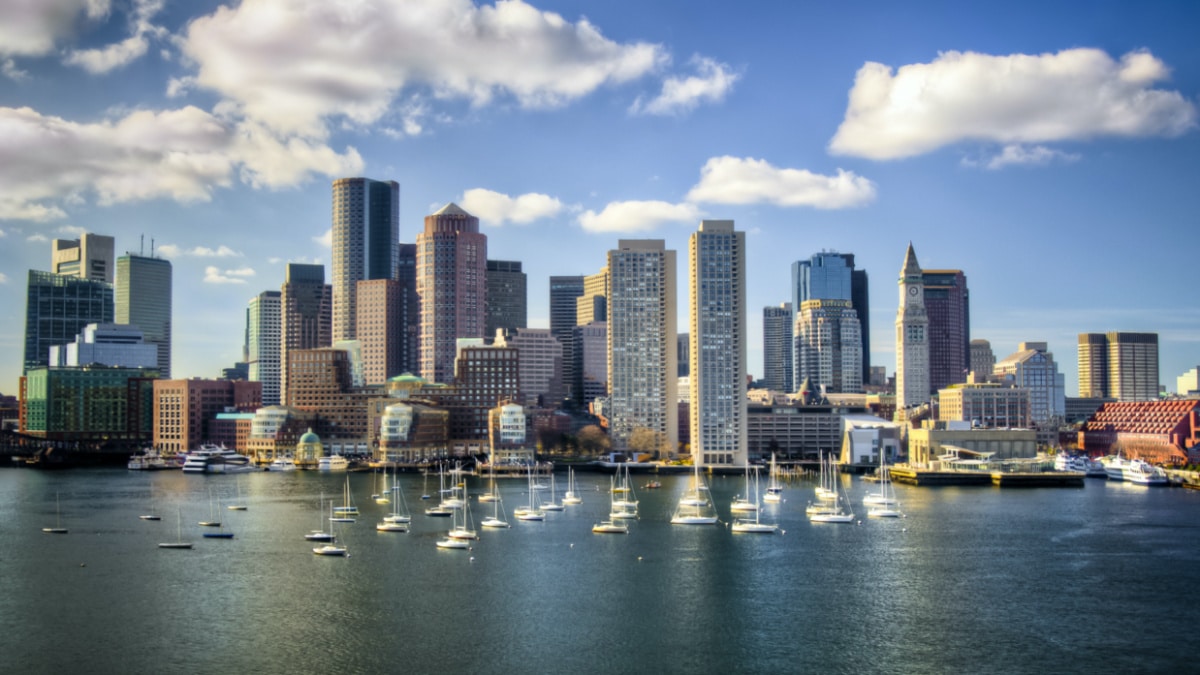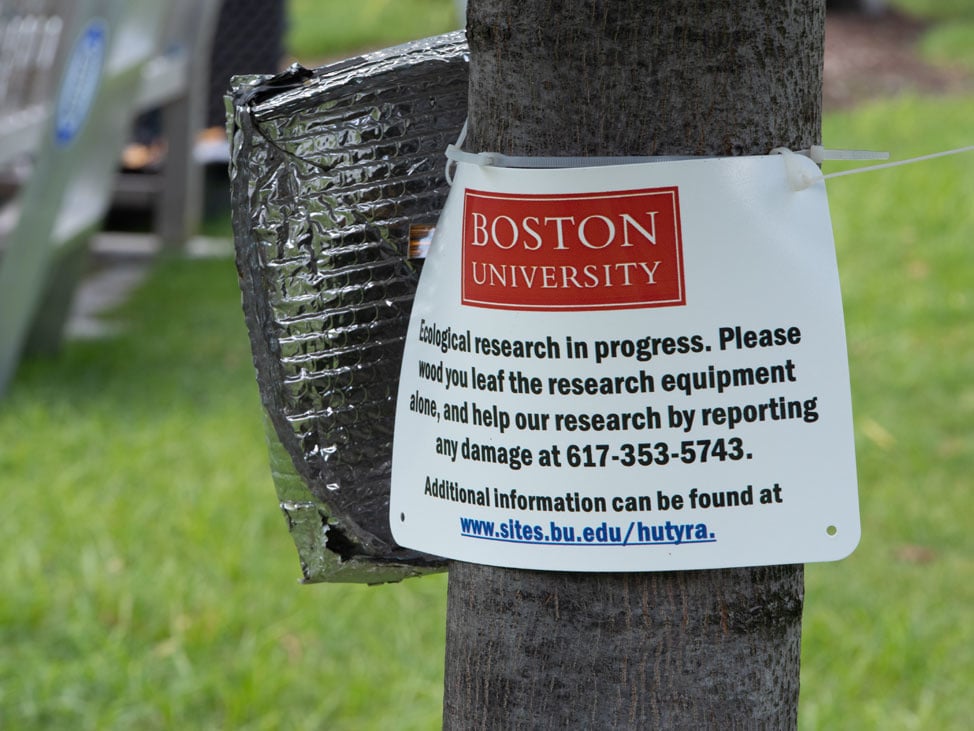

Boston scientists are using different methods to measure the city's carbon emissions. Tomasz Szulczewski / Getty Images
By Daniel Grossman
Millions of stacks and tailpipes in cities around the world send up 70 percent of the carbon dioxide ejected into the atmosphere by human beings. And in the parts of the world, including the U.S., where many governments at all levels have offered only anemic or counterproductive responses to the climate crisis, officials in some cities are acting. Four hundred and sixty one mayors, including those of some of the U.S.’s largest cities, have joined Climate Mayors. They’re pledging to uphold the goals of the 2015 Paris Climate Agreement, regardless of whether the U.S. remains in or bolts from that pact.
How can leaders choose carbon-cutting policies with the most impact? And how can they check to see if they’re getting it right?
This past summer, Lucy Hutyra, a climate scientist at Boston University who studies urban fossil fuel use, invited me to see her latest research on tracking carbon dioxide emissions.
I bicycled over to BU Beach, an oasis of green on the highly urban university campus. Above her, Barry Logan, her colleague, balanced on a step ladder poked into the canopy of a linden tree. He pressed single serrated leaves against a soda-straw-thin metal tube, its tip sharpened like a leather punch. He shook a green plug of vegetation out of the tool and folded it inside a thumbnail of tinfoil. Hopping down from the ladder, he dropped the Lilliputian sample into a fuming tank of liquid nitrogen, 320 degrees Fahrenheit below zero.
Along with Logan, a plant physiologist, two other researchers had come along with Hutyra on that blistering August day. They sampled several trees in the park. They’d swathed in bubble wrap and strapped a device that measures sap flow to the trunk of a mature tree. And they’d deployed a little humor in the hopes of deterring would-be vandals. “Please wood you leaf the research alone,” implored a sign on the tree.

Daniel Grossman
Hutyra’s research is part of a wide-ranging campaign to improve estimates of fossil fuel emissions exhaled from the world’s cities measured through time. By coincidence, Boston Mayor Marty Walsh, whose office is a few miles east of BU Beach, co-chairs Climate Mayors. His administration has made an ambitious commitment to make Boston carbon neutral by 2050. Hutyra’s research could help Boston, and any other city, determine if it has succeeded. The political commitments produce physical results, she said. “If you have the state and city governments making pledges to reach carbon neutrality, it should be actualized in the atmosphere.” Then she added with a smile, “and we can measure that.”
Precise Sensor Atop Boston Skyscraper Gets CO2 Readings Each Minute
Steven Wofsy, a Harvard atmospheric scientist, is collaborating with Hutyra to hone a technique to make such measurements. Boston is also a test bed for him. He takes air samples 700 feet above the downtown’s swankiest shopping district.
In 2012, Wofsy installed a precision gas sensor atop one of Boston’s tallest skyscrapers, near Copley Square in downtown. It has since recorded the amount of carbon dioxide in the air, once each minute. He put five such detectors in a network, three on the far edge of the metro area, sampling background levels, to the north, south, and west.
Wofsy has hired a colleague’s former grad student, Maryann Sargent, to perfect a method for tracking urban fossil fuel using his sensors’ measurements. She simulates carbon dioxide flowing through the city’s skies by conducting a virtual experiment. She hypothesizes that at some specific time and day, 1,000 infinitesimal parcels of air drift into the downtown detector. Call that time zero. Then, in the simulated place that she calls “model world,” Sargent turns the clock backward one minute from the start of the experiment. Using actual wind records, she calculates where the parcels were from at that earlier time. And she determines how much carbon dioxide they must have borne then.
Like an Agatha Christie sleuth who has discovered a body, a murder weapon and a trainload of suspects, Sargent begins her work with the end result and a cast of the characters. One step at a time, to “solve the crime,” she figures out how they converged in the final act. It’s the only way for her to learn where the downtown air came from and what happened to it along the way.
Moving backward in time, Sargent computes how the carbon dioxide content of each air parcel changes in each minute of its reverse travels across the city. In this topsy-turvy, Alice-in-Wonderland scenario, fossil-fuel burning gradually removes carbon dioxide from the parcels. With the time in repeat, plants, which we normally think of as removing carbon dioxide, add it. Sargent uses two inventories of data that Hutyra has created, one tabulating carbon dioxide emissions from Boston’s smokestacks and tailpipes, the other cataloging uptake of carbon dioxide by the city’s vegetation.
Scraping information from databases such as cell phone logs – which record vehicle travel – and utility records – which show building energy use – Hutyra has computed hour-by-hour estimates of emissions within each cell of an imaginary grid of one-kilometer squares overlaying the Boston area. She’s totaled estimates of the exhaust from every building, vehicle and, of course, electricity generating station within every cell.
In the other inventory, Hutyra has tallied plant uptake within each grid cell each hour of daylight (plants don’t perform photosynthesis and take up carbon dioxide at night). Trees cover 27% of Boston’s surface. The percentage increases in the verdant suburbs. Sargent says the databases clearly show that at times urban vegetation substantially reduces the amount of carbon dioxide added to the city’s air. On some sunny days in some parts of Boston, plants take up more carbon than is added by fossil fuels. It would be pointless to simulate carbon dioxide concentrations in a verdant city like Boston, she says, without factoring in plants.
Sampling a Linden Tree ‘Not Behaving Like a Textbook Tree’
The day I visited BU Beach, Hutyra was refining her techniques for compiling plant uptake inventories. Among past findings, she has discovered that urban trees absorb twice as much carbon dioxide as the same size trees in a forest, a discovery with serious implications for her calculations. “This tree is not behaving like a textbook tree,” she said, patting the linden they’d sampled. Compared to their forest counterparts, such urban trees get pampered with fertilizer and water.
From a nearby building they’d aimed a specialized camera that helps estimate a plant’s carbon uptake. Logan took his leaf samples, frozen to the point of suspended animation, back to his lab, to compare tried-and-true laboratory methods for gauging leaf absorption of carbon dioxide with data from the newly-devised camera. He says that with more testing, carbon uptake by urban forests might someday be monitored with similar cameras circling on satellites.
Sargent rewinds time backwards in model world, minute by minute, carrying those imaginary parcels in an expanding cloud ever back in time and upwind. For each increment, she computes the amount of carbon dioxide each parcel exchanged with the surface, through the effects of fossil fuel use or plant growth. In time – three to twelve hours depending on wind speed – the imaginary cloud of parcels exits the metro area and passes by the location of one of Wofsy’s rural detectors (which one depends on the wind direction of the simulated day). This is where the model-world experiment ends, a place where the carbon dioxide concentration is largely unaffected by the city.
From Military Intelligence to Climate Intelligence
In a 2018 paper in the Proceedings of the National Academy of Sciences Sargent, Hutyra, Wofsy and eight coauthors compared how much carbon dioxide those simulated air parcels lose moving backwards from downtown to the city’s edge (or, equivalently, the difference in carbon dioxide concentration between the two places) with actual measurements from Wofsy’s sensors. The simulated and actual numbers produced by the two methods were almost identical, within 14% of each other. Wofsy says the agreement between the figures proves that the model world closely resembles the real world, showing “our methods are not crazy.”
With these methods, Sargent says, researchers can soon chart urban emission trends anywhere, even absent the painstaking inventories Hutyra tabulated for Boston, with no further boots on the ground: Orbiting carbon dioxide sensors combined with satellite photos will give them what they need.
In the near future when some country claims a city has made emissions reductions to meet obligations under the Paris Climate Agreement, researchers will be able to investigate the assertion, even if they aren’t given data to justify it. Orbiting sensors, once intended for military intelligence alone, will now empower our climate intelligence. With satellite measurements of carbon dioxide concentrations and urban greenery across the city, and with images showing where people live, and the highways network and locations where electricity is generated, regulators could make a crude simulation of how the concentration of carbon dioxide changes across the city, just as Sargent did in Boston … and verify how much carbon dioxide was emitted there.
If satellite readings of the carbon dioxide concentrations they see don’t line up with the claimed emissions reductions, a closer look might be worthwhile. As climate scientists like to say, the atmosphere doesn’t lie.
Reposted with permission from Yale Climate Connections.
- 21 Countries That Reduced Carbon Emissions While Growing Their ...
- Carbon Emissions Rise to Highest Level in at Least Three Million ...
- Wealthy One Percent Are Producing More Carbon Emissions Than ...

 233k
233k  41k
41k  Subscribe
Subscribe 